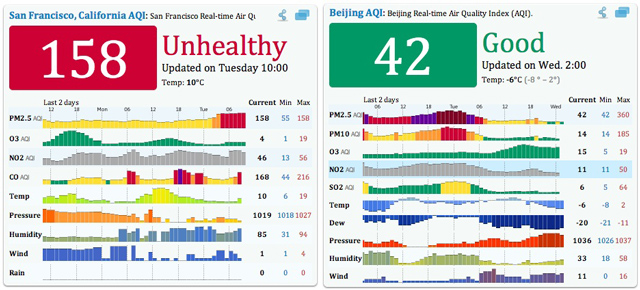Look, we make a lot of jokes around here about the futility of winter Spare the Air days and how you shouldn't burn wood and whatnot, but this morning we're taking a comparative look at the Air Quality Index in both San Francisco and the notoriously smoggy city of Beijing. As it turns out, this windless cold snap means our air quality index is actually worse than China's capital at the moment.
On the left: San Francisco's Air Quality Index around 10 a.m. Tuesday morning. On the right: Beijing's current Air Quality Index at 2 a.m. Wednesday (local time).

Obviously a lot of different factors go into measuring the Air Quality index, but the top line (PM 2.5) is an EPA standard measure of the concentration of particulates 2.5 microns or smaller in the air. It's been in the yellow 51-100 range for the past 10 days, which triggers these Spare the Air days and means sensitive groups should limit prolonged outdoor exertion. Yesterday evening, that jumped up to the "Unhealthy" 151-200 range. (Were you burning something? For shame.) At the current levels, the BAAQMD recommends:
Active children and adults, and people with respiratory disease, such as asthma, should avoid prolonged outdoor exertion; everyone else, especially children, should limit prolonged outdoor exertion.
According to the BAAQMD, levels above 200 have not been recorded in the Bay Area in decades, and we're still not nearly as bad as Tianjin, to the south of Beijing where AQI scores are in the 500-range, which has never happened in North America.
Anyhow, keep those inhalers handy, folks. And we never thought we'd say this, but let's hope for a nice wintry breeze sometime soon.
Update: As if you needed visual evidence of the smog, here's a brief video comparing the clear and hazy views from San Bruno Mountain. The clear view is from 7:40 a.m. on November 5th and the hazy shot you see is from 8 a.m. Tuesday morning:
Update II: Wednesday's air quality is less apocalyptic.
Hat tip: Burrito Justice.
[BAAQMD]
[AQICN.org]

